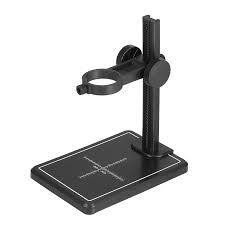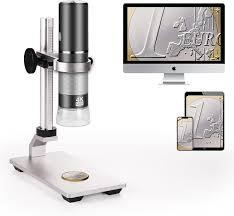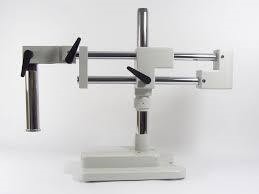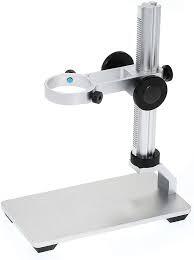Microscope stands support microscopes for clear and stable views. These stands come in two types: portable and fixed. Each type has specific benefits. Choosing the right one improves ease of use and image quality.

Portable Microscope Stands

What They Are
Portable microscope stands are light and compact. They’re easy to move around. Many models have adjustable arms to change angles. Portable stands are common in schools and for fieldwork.
Pros of Portable Stands
1. Mobility: They are easy to carry to different places.
2. Space-saving: Portable stands are small and simple to store.
3. Adjustable: Some models have flexible arms for easier viewing.
Cons of Portable Stands
1. Less Stable: They don’t always hold as steady as fixed stands.
2. Weight Limits: Portable stands may not hold large microscopes.
3. Less Durable: They can wear out faster with frequent moves.
Best Uses for Portable Stands
– Field studies or outdoor labs.
– Classrooms with limited space.
– Remote labs need lightweight tools.
Fixed Microscope Stands

What They Are
Fixed microscope stands stay in one place. They’re sturdy and made for precision work. Fixed stands are common in labs, clinics, and research facilities.
Pros of Fixed Stands
1. High Stability: These stands reduce vibrations for clear images.
2. Durable: Fixed stands last long, even with regular use.
3. Heavy Support: Fixed stands can hold bigger microscopes.
Cons of Fixed Stands
1. No Mobility: Fixed stands are hard to move once set up.
2. Takes Up Space: They need a dedicated space in the lab.
3. Higher Cost: Fixed stands often cost more than portable ones.
Best Uses for Fixed Stands
– Labs needing stable tools for long hours.
– Clinics and research labs.
– Industrial sites with permanent workstations.
Portable vs. Fixed Stands
| Feature | Portable Microscope Stands | Fixed Microscope Stands |
| Mobility | High | Low |
| Stability | Moderate | High |
| Durability | Medium | High |
| Cost | Low | High |
| Best For | Field, schools, small labs | Labs, clinics, industry |
How to Choose the Right Microscope Stand

1. Microscope Type
Some stands only hold small or light microscopes. Choose a fixed stand for heavy microscopes.
2. Type of Work
For fieldwork, choose a portable stand. For lab work needing stability, go with a fixed stand.
3. Space Available
Small spaces work well with portable stands. Fixed stands fit large, dedicated labs.
4. Budget
Fixed stands cost more. Choose portable stands for budget-friendly options.
5. Environment
Portable stands suit changing environments. Fixed stands work in steady spaces.
Tips for Using and Keeping Microscope Stands

– Align Properly: Check the alignment each time you use it. This keeps the lens in line with the sample.
– Handle Carefully: Move portable stands with care. This helps them last longer.
– Clean Often: Wipe stands and microscopes often. Clean tools last longer.
– Check Stability: For fixed stands, tighten loose parts often.
Availability in Other Countries
1. Asia
– China and Japan: China is a major producer of microscope stands, with many affordable models available for export. Japan, known for its high-quality optical equipment, supplies high-end microscope stands through brands like Nikon and Olympus.
2. Middle East and Africa
– South Africa: Microscope stands are accessible through scientific equipment suppliers and larger online platforms, catering to both educational and professional markets.
3. Oceania
– Australia and New Zealand: Microscope stands are available through science equipment suppliers and online marketplaces. Australian suppliers like SciTech and New Zealand’s Science Supply Co. offer a range of microscope stands for educational, research, and industrial purposes.
Final Thoughts: Which Stand is Best?
Both portable and fixed stands have key uses. If you need mobility, pick a portable stand. If you need stability, pick a fixed stand.

